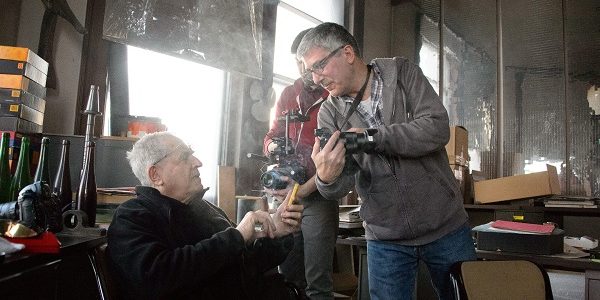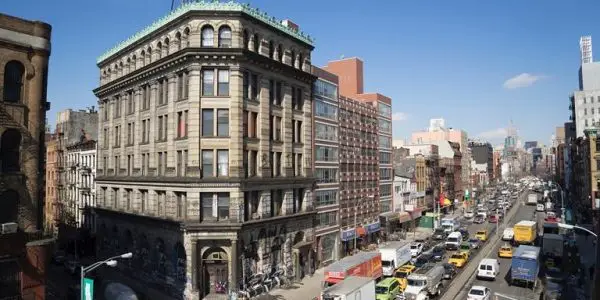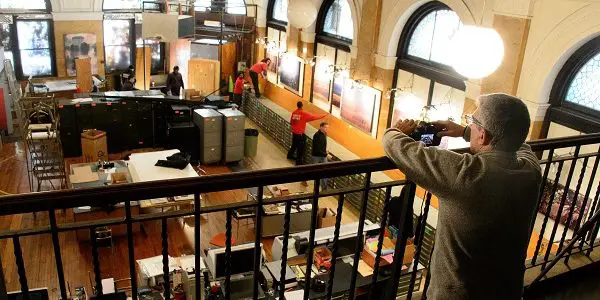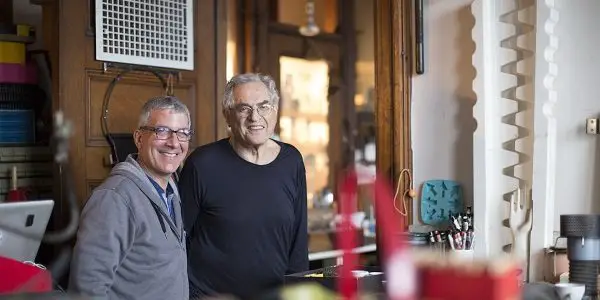JAY MYSELF Director Stephen Wilkes Dives Into The Art Of Portraying A Collection Of Time And Space

Janet is a writer based in Salt Lake City. A…
Photographer and director, Stephen Wilkes has made his directorial debut in the poignant, funny, and unique documentary, Jay Myself. He documents his mentor, long-time friend, and legendary photographer, Jay Maisel, moving out of his 35,000 square foot home and former bank after nearly 50 years inhabiting in such a renowned space. Not only does the film become an entertaining look at a large moving feat, but an ode to an artist’s life and career that was in many ways, molded and shaped by The Bank.
Deemed as a collector of objects, Maisel permeates with nostalgia, evoking an emphasis on process over product. It makes an obvious yet necessary reminder that in life, things change and are constantly evolving. Thus, we must take time to see things–let it all absorb.
Film Inquiry had the pleasure of speaking with Wilkes. We discuss the essence of time and space and how Wilkes ingrained these components to his narrative. As an iconic photographer, known for this fine art, editorial, and commercial work, he shares his journey from photography to filmmaking, and how his drive to capture time and space applicably translated into capturing the enormity someone’s life and vision.
While discussing his documentary, his admiration for Maisel glows. It’s certainly a sweet and honorable mentor and mentee relationship that’s flourished into an endearing friendship. Having had the pleasure of working under his wing for several years at The Bank, Wilkes is keen to show that The Bank wasn’t simply a magical place where it bred discoveries for its owner, but for many others around him.
Janet Lee for Film Inquiry: Let’s start with your relationship with Jay. You’ve been his mentee and close friend for decades and I felt that it really showed throughout the film. What was your vision of the film prior to shooting it, and how do you think it might have evolved during production?
Stephen Wilkes: I’ve known him for about 42 years now. I used to tease and say to him, “if you ever move, you have to let me film the move, because this is going to be like the mother of all moves of all time.” [Never in our minds] did we think he’s ever going to be leaving this space.
And so at 84 years old, he called me up and he said, “hey man, I’m selling it.” And it was suddenly at that moment where I realized that this thing was actually going to happen, and the memories that I had in that building was really the beginning of my formative years in the business at the time in photography really. And he was my main mentor for most of my life. I knew that was all going to disappear. I realized in that moment that I could not only tell the story of The Bank, but actually tell Jay’s life story through the move, using the move as a vehicle for the film.

I didn’t really know exactly how it was going to all come together [laughs]. Like one of the things that I’ve learned from Jay, and I think intuitively has an artist, I have a general idea of what I like to do, and I like to do my homework. But then I like to live in the moment. And I like to react to what is presented to me and what’s in front of me. We had really a hard timeline to deal with, which was challenging, but from a narrative standpoint, was really important, because I knew I had to get certain things before they disappeared. So I had this [attitude] that you see something, and you better shoot it, because it may not be there tomorrow.
And with Jay, I found myself really wanting to create a portrait of him that had this dimensionality into the person he was to me. I wanted you to see him the way I see him. And I wanted you to experience The Bank in a way that I experienced it too. I think Jay is such an interesting character, and I think people just kind of fall in love with him within the first ten minutes of the film.
He’s uniquely New York. He’s got the cigar, the lisp, and the whole thing. I knew that you could fall in love with Jay, because I know how charming Jay is, his physical presence, his wit, his sort of curmudgeon kind of quality he brings, but he has this directness that I think most people find quite refreshing; you find him really entertaining. But I think the challenge was to be able to make you fall in love with the building at the same time.
And I think it’s when those two things come together that you then have the connection that I had to this experience, and I think that’s what really gives the film in the end its power. It was something that you know, I looked at in multitude ways in a sense of I wanted to again, create this dimensional portrait of Jay, but there were certain specific moments in the film that I see those things in a sort of subtextual way. You begin to realize that you’re connected to this place in a way that you feel empathy for the building and for what Jay’s experiencing.
I had a great team, a really great team. A young cinematographer, Jason Greene, who helped me on all the steadicam shots, my assistant at the time, Chris Janjic. We were just a very small crew. Everyday was like groundhog day. We didn’t know what was going to be happening. In a way, Jay’s philosophy really also applied to the move.
The structure for me was my insistence on doing separate interviews with him, within the context of this experience. He always says, “you can never smell yourself.” He never saw the story of him, himself, his being a great story, and his life in that bank being a great story. I hadn’t in over 42 years, had these really deep conversations with him about everything and the whole idea of what photography is, so what I wanted to do was I wanted you, the audience, at the table with me during those conversations. Like I wanted you to experience all the things that I think he has shared with me.
There was a certain degree of for me, wanting this film to be this experience that’s like this gift where you can watch Jay, listen to Jay, and go into the bank, and experience this place in a way as Jay said, “everything just goes away.” The act of seeing becomes this wonderful escape.
Yes I really liked that emphasis on the process over the product. And as you mentioned, it’s about the act of photographing, and I feel it’s also really reflective of the current digital age that we live in, because everyone’s so ingrained in their phones and other devices. So when you were weaving in this theme of process over product, was this something that was reflective during production?
Stephen Wilkes: I’ll tell you two things. One was, we came together during the peak of analogue, like it was a wonderful time in the world of photography, and I felt lucky enough because I actually was able to get the best of analogue in my career, and then I was fortunate enough to be young enough to adapt to digital.
I think what I have always loved about art when I spent time with Jay, is that we would just look at things. [This act of looking] is becoming an endangered form of human behavior. And there was definitely for me a sense in the film that Jay’s space was like how I described in the film–he’s like the Wizard of Oz. It was like the Oz of photography. It was like this visual fairytale of a structure. If you come in and you’re curious digitally, forget about it–you’ve reached Nirvana there. It was that layered, it was so deep in terms of what was there that you couldn’t take it in upon one seeing.

Our history and certainly in the most formative years of my life, were at a time where there were no cell phones, when it was an analogue period. If you think about the tectonic shifts in terms of just the way people interact nowadays, versus where it was in the eighties, it’s kind of staggering. Even though Jay shot digital since I think in the early 2000s, the truth is the bulk of his life and the bulk of his career, was all analogue. So I really wanted to represent that aspect of it and I think in many ways, you know the scale of who he is, is really on this monumental 100 year old bank building.
I was looking at some of your photos from your Ellis Island and Day to Night projects, and you really captured incredible depth and texture within all your frames. And they really reminded me of a lot of the shots in Jay Myself, as you were capturing the enormity of Jay and his career. Can you describe what your experience was like going from photography to filmmaking and how photography might have contributed to your filmmaking experience?
Stephen Wilkes: Well, I always considered myself to be a storyteller. And as I’ve evolved as a photographer, like you mentioned, my Ellis Island work, I started to begin to make single images that had something else going on in them almost like there was a subtext to what you were seeing. So from a story and a narrative standpoint, you see this beautiful room, this gorgeous light, the paint, the patina, but there’s something else that you feel in these pictures. I described it to people as history in the light of these empty rooms, and I think once I started to be able to make pictures like that, it’s like anything comes in that benchmark. You want to tell more stories, you want to get richer, further and deeper into that kind of narrative image making.
In many ways, there’s a big time element in this film. I kind of go back and forth in terms of time, and one of the things that really helped me was my background as a still photographer. When I did Day to Night, people would look at it and go “my god, it’s like a movie in a still photograph.” There’s all these narrative stories as time changes through the image.

But one of the things that I found fascinating about being a first time filmmaker was, I could work on that level to a certain degree, but there was something else about it. It was the idea that I could feed you, the viewer, in a longer movie. So where as a still photographer, I need to almost communicate that idea within a few moments of you looking at the photograph, hopefully when you spend enough time and you look deeper, you’re rewarded. But in a film, you get to sort of sprinkle that message. Because I don’t have to show all my cards upfront, it allowed me to communicate core emotional things that I wanted you to feel that hopefully, if you connect, it will all be little nuances throughout the story. Those points really come together when you walk out of the theater. You see something in the street that suddenly connects back to the film. So that’s what I loved about [filmmaking].
And so I think [photography] definitely helped me. By the same token, I felt the more I dived into working with the editing, developing the stories, and creating what I described it as this dimensional portrait of this man, the more I gave you the experience in the building that makes you feel like you were there.
Those things excited me in a way because I knew if I could just bring the impact that I can in a still image, if I could leverage some of that with this kind of idea of feeding an emotional narrative in the film, it really could be very very powerful. I think actually having a background as a photographer is a great gift. I think the challenges in filmmaking as a photographer is that you work mostly as an individual, as a photographer. And I think as a filmmaker, it’s a collaboration, and as a director, I learned how to be a really good listener. I learned how to be someone who can sound off people, can hear what they’re saying and give creative people their freedom to do what they do really well.
But at the end of the day, I have to have the objectivity to know when the story is not going where I want it to go, or what I’m left with is not the way I’m wanting to feel. And those are the things where you’ve got to make a change. So those are the kinds of challenges of comparatively being between a still guy and the director of film. And I think the challenge though becomes when you have to be able to collaborate in a way that allows you to get really what you want. In the end, it’s your story you know.
What kind of equipment did you guys use during production?
Stephen Wilkes: I shot it on a 4K video system. We didn’t use any lighting. The only thing of course, the portraits that I did in the interviews…one of the reasons I did the interviews the way I did them was I didn’t want to take you out of The Bank in a way you know. Once we went in the building, I wanted you to sort of almost, take you to like somebody else’s location in their backyard talking to Jay. I always loved the movie Reds, and I wanted to keep it really simple like that. And just talk about Jay and then allow the images–Jay’s images–to really speak. If you’re going to go anywhere, you’re going to travel through Jay’s work.

Yeah, I felt that the natural light worked really well in the film.
Stephen Wilkes: Well that’s the thing about The Bank honestly, is that it had such extraordinary light and when you watch the film, you’ll notice that what was interesting was that of course, he moved in the dead of winter. It got colder and darker. Historically, it was almost like the window was closing, the light was disappearing, everything got bluer, and Joel Goodman’s score became more and more minimalist. It was like being deconstructed as the building was being deconstructed and that was really an important thing for me. I wanted to really emphasize how things were disappearing.
Even in that scene where you see Jay shooting the ice crystals on the windows, and I remember what I had to do to make that happen. I had known that the ice crystals was one of his great bodies of work that he’s done for decades. I thought, it would be so great if I can do a scene with him and the ice crystals. I thought if we were lucky enough to get the ice crystals, I could do it. And so we got this really wicked cold snap during one of the last weeks of filming the move. I set up the camera overnight at four in the morning and sure enough, the ice crystals happened. The way they come up on the screen, you can see them and then they melt in front of your eyes and then they dry up and just disappear. You know, it was very poignant for me that scene.
The Bank not only molded and shaped Jay’s life and but your life and vision as a photographer and as his mentee. So can you share what your experience was like seeing him move out of The Bank and what it meant to you?
Stephen Wilkes: For me, the film as three points. One of them is a love letter to Jay because you feel that relationship and connection we have, it’s a love letter to photography, and then it’s a love letter to New York–the end of an age in New York, an end of an era in New York. A moment that I don’t think we’ll ever really see again in New York City. And you know, it was quite emotional for me honestly.
I mentioned to you my formative years…my wife Bette I met when I was working [at The Bank], she met Jay before she even met my own parents. In fact, when he met her for the first time, he was very paternal with me, he looked at her, he lowered his glasses and he goes, “so you’re Bette. What exactly are your intentions?” [laughs]. So that’s just one sort of memory that I have, so it’s like the woman that I married, the love of my life, the person who really changed my life in so many ways, who shaped my career in so many ways, and then you know it was that building.

When I used to go down there [in 1979], I used to see Keith Haring doing Barking Dog on the sidewalk, and I’d come in at eight in the morning, and I’d go for coffee, and it’d be like Louise Nevelson, the great sculptor, would be having a cappuccino wearing a turban on her head. It was such a magical time to be there. You had the CBGB and The Talking Heads, and it was just an incredible time to be on the Bowery and even though it was rough and everything, it was the most fertile, creative place to be in.
My work is a lot about memory in a way. We all have collective memories. It’s like there are things that touch us throughout our lives that are sort of stored in our collective memories. The final moments when the doors were locked, it was over. It was profound.
He’s quite a stoic man. He doesn’t really show emotion. I felt that the Bank and Jay were connected. And I think that Jay occupied The Bank in such totality and such power that as he was deconstructing it, you could almost feel like there were things being taken away from him in a way. And you could see it in the film. He’s sneezing, he’s got a horrible cold at the end of the film.
At 88 years old you think, “I think my bed is pretty much made at this point.” Not Jay, not Jay. He calls me up about four months ago, he’s got this gleeful tone in his voice. He goes, “I got a place man…I just got two doors away, the parking garage, I’m taking it over…I’m bringing 11 truckloads back.” I mean, unbelievable…88 years old. He’s doing it all over again. He’s just a remarkable remarkable person.
Just when you thought it was safe to close the door, lock the key, and move to the next chapter, no, Jay is going to rewrite the book. I always find that artists who can continue to stretch in different things, you know, push boundaries, is incredibly inspiring. The old dog still has a few new tricks.
What is coming up next for you?
Stephen Wilkes: So my book, Day to Night, just came out with Taschen. It’s just an incredible book the way they’ve done it, so I’m super excited. And I have a big opening [exhibition] coming up. I have a big show in Dubai in September, I’ve got a show in Santa Fe early October, L.A. at the end of October, and New York City at the Bryce Wolkowitz Gallery on September 12th. And I’ve just been given another grant by the National Geographic Society. I’m moving my work now into endangered species and habitats. I’ve been documenting Canadian endangered species and habitats over the next two years. It’s like my side project, but it’s going to be very exciting.
We’d like to thank Stephen Wilkes for taking the time to speak with us.
Stephen Wilkes book is available at Taschen.
Watch Jay Myself
Does content like this matter to you?
Become a Member and support film journalism. Unlock access to all of Film Inquiry`s great articles. Join a community of like-minded readers who are passionate about cinema - get access to our private members Network, give back to independent filmmakers, and more.
Janet is a writer based in Salt Lake City. A strong advocate for underrepresented voices, she believes cinema is a transformative medium that challenges assumptions and creates diverse conversations.













